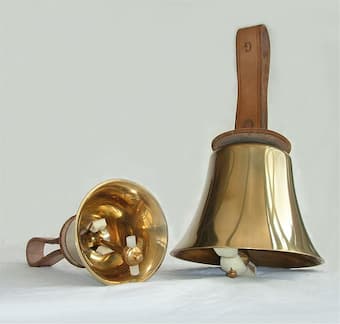
Whitechapel handbells
Depending on your location, there might already be a touch of frost in the air. Days are getting shorter and the nights much darker and longer. There might even be a whiff of snow in the air. Judging by the way shops and malls are being decorated, you know that Christmas is once again around the corner. Growing up in Hong Kong, snow was never really a possibility, but one of my favorite Hong Kong Christmas traditions is to listen to the ringing of bells. Nothing gets me in the festive mood of Christmas like Christmas music performed by handbells or handbell choirs. Handbell music started in the UK over a century ago, and handbell sets are a combination of individual bells of different pitch. The bells generally include all the notes of the chromatic scale, and a small ensemble can ring recognizable music with melodies and harmonies. A handbell ensemble acts as one instrument, with each musician responsible for particular notes, sounding his or her assigned bells whenever those notes appear in the music. It is actually very difficult to perform a piece of handbell music, because it needs great cooperation, coordination, and also a conductor. It is not only dazzling to watch a performance, but the glittering sound of so many bells puts me in the Christmas mood immediately.
Christmas Hymns: BPMC Hand Bell Choir

Hong Kong Youth Handbell Ensemble
In Hong Kong we have a dedicated Handbell Association and Academy, and Mr. Ralph Yoars, a Southern Baptist missionary started the tradition of handbell music in the city. He was sent to Hong Kong to engage in music education and publicity work, and he was appointed as an Associate Professor at Hong Kong Baptist University. The first set of Schulmerich handbells arrived in the early 1970s, and Hong Kong Baptist University established a Handbell Choir. To this day, “the Hong Kong Baptist University and the Hong Kong Institute of Education are the only two tertiary institutions with their own handbell groups in Hong Kong.” More recently, independent amateur handbell teams have been established, and Hong Kong has seen as “steady growth in the number of newly formed handbell, handchime and belleplate teams among schools, churches and other organization.” In fact, the Handbell Association of Hong Kong organized the first “Hong Kong Handbell Festival,” and the “School Handbell Competition” in 2006.
Hong Kong Youth Handbell Ensemble

Hand chimes
The handbell is an instrument usually made of brass or bronze, but sometimes also of copper, clay, porcelain, glass, wood, or other hard material. The handbell either comes with an attached stem, or a leather strap for a handle. The clapper heads are traditionally made from leather, but modern materials such as plastic and rubber produce pretty much the same effect. To ring a handbell, the ringer moves it in such a way that the clapper strikes the inside surface of the bell, usually holding it against his or her shoulder, bell upwards, and then swinging the bell through an elliptical shape to cause the clapper to strike the casting. The tone of the bell will continue to resonate, decaying naturally until it stops completely or the ringer stops it by damping the bell with a hand or on the body or a padded surface. Handbells come in a variety of sizes, and different performance techniques bring out distinctive sounds. While an individual handbell can be used to catch people’s attention, handbells are often heard in tuned sets to produce clear and beautiful melodious music.
John Francis Wade: Adeste fideles (O Come All Ye Faithful) (arr. B. Burroughs for handbell ensemble) (Embellish Handbells)

Handbells set
A delightful variation of the handbell is the mellow and soft handchime. This instrument is made of aluminum and rung by hand, similar to handbells. Typically, handchimes are tuned square tubes with an external clapper mechanism, and many handbell techniques can also be applied to handchimes. Handchimes are frequently rung in conjunction with handbells, and soloist might play handbells and handchimes at the same time or alternate between the two. In most cases, a ringer plays two bells at a time, one in each hand. On occasion, however, a ringer needs to move up and down a range of bells or chimes. A special weaving technique can be employed so that more than two bells or chimes can be rung in short succession, “using the table to damp and free the hand to pick up the next bell.” You can see this technique in ensembles, and also in magnificent solo performances.
O Holy Night

Handbell side and bottom view
For me personally, however, the most impressive handbell demonstrations are by master ringers who have the ability to hold two or more bells in each hand. “Four-in-hand” technique means that two bells in one hand are held with the clappers at right angles to each other. This allows the two bells to ring independently, or they can also be played simultaneously. If you think that playing four bells at the same time is difficult, you haven’t seen master ringers who play six bells at a time, three bells in each hand. I read that there are several complicated techniques available to the ringer. While we can marvel at their technical mastery, it is the music that’s most important. To me personally, nothing expresses the joy of Christmas with more bliss and more delight than the ringing of Christmas Bells. Merry Christmas everybody!
For more of the best in classical music, sign up to our E-Newsletter
Solo Handbells Christmas Medley



